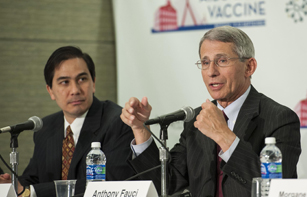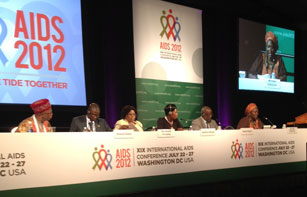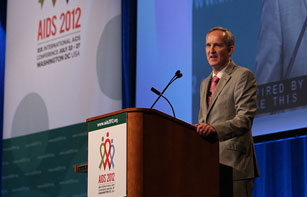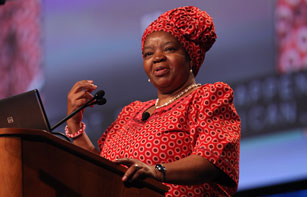
Sex worker initiative Veshya Anyay Mukti Parishad (VAMP) give a performance at the opening of the Sex Workers’ Freedom Festival in Kolkata, India.
Credit : UNFPA/J.Cabassi
As thousands of delegates gather for the XIX International AIDS Conference (AIDS 2012) in Washington, D.C. this week, a parallel satellite hub, the Sex Worker Freedom Festival, is taking place in Kolkata, India, from 22-26 July.
The event brings together over 600 sex workers, international and national partners from more than 40 countries. The Freedom Festival has been organized by sex workers as a response to extensive visa regulations for sex workers and people who use drugs, which may have prevented many from attending the International AIDS Conference event in Washington DC. The five-day festival gives participants the opportunity to be part of the Washington event through video-conferencing link up with major conference sessions and with the Global Village.
“The Sex Worker Freedom Festival is an alternative event for sex workers and our allies to protest our exclusion and ensure the voices of those excluded are heard in Washington.” said Ruth Morgan the Global Coordinator of the Global Network of Sex Work Projects (NSWP) and Co-Organizer of the Kolkata event.
Speaking at the opening of the Kolkata hub, United Nations Secretary General’s Special Envoy on AIDS in Asia and the Pacific, Prasada Rao, stressed that freedoms and rights of sex workers are being denied on a daily basis.
“Aspects of sex work are criminalized in 116 countries around the world. Laws in many countries conflate adult consensual sex work with human trafficking. Routine police raids, often in the name of anti-trafficking, lead to arrest and harassment of adult consenting sex workers,” said Mr Rao. “These discriminatory practices drive sex workers to social exclusion and into a socially disadvantageous position, accentuating their vulnerability to HIV,” he added.
Despite progress made in reducing the spread of HIV within sex work communities, sex workers are still at increased risk of HIV infection. In the Asia-Pacific region for example, while a number of countries have reduced their HIV infection rates with intensive HIV prevention programmes among people who buy and sell sex, hotspots of high prevalence remain. Surveys of female sex workers in India show prevalence of 18% in Maharashtra and 41% in Pune—the overall adult level in the country is an estimated 0.3%.
Sharing experiences, driving progress
The Sex Worker Freedom Festival programme is structured around fundamental freedoms; human rights that all people are entitled to. These include freedom of movement; freedom to access quality health services; freedom to work and choose occupation; freedom to unionise; freedom to be protected by the law; freedom from violence; and freedom from stigma and discrimination.The Festival aims to facilitate the sharing of experiences as well as dialogue around key issues and priorities for the sex work community and HIV programming.
“Without the right to organize and unionize the sex worker community cannot advance our rights,” stated Bharati Dey, General Secretary, Durbar Mahila Samanwaya Committee (DMSC), co-organizer of the Kolkata Hub.
Discriminatory practices drive sex workers to social exclusion and into a socially disadvantageous position. This accentuates vulnerability to HIV
United Nations Secretary General’s Special Envoy on AIDS in Asia and the Pacific, Prasada Rao
The stigma and discrimination experienced by sex workers was identified as a major obstacle to an effective response to AIDS. “Every day and in every location, we have to battle against stigma and discrimination,” said Lakshmi, a sex worker and the Director of Programmes at the Ashodaya sex worker initiative in Mysore, India, said. “We have found a way to be part of the solution. Our team of HIV positive sex worker volunteers has built an effective partnership between communities and health services. This has changed attitudes of health care providers and has created community confidence to access health services.”
Annah Pickering, a sex worker and Manager of the Auckland Region, New Zealand Prostitutes Collective, underlined the multiple benefits of decriminalization of sex work in her country, both for sex worker rights and the HIV response. “We appreciate many legal freedoms. We can report corrupt officials who demand free sex. We don’t hide our condoms in our bras or behind the picture or in the thermos flask. We can put up signs and promote safe sex and insist on it. Does decriminalising sex work prevent the transmission of HIV? I strongly believe so. When you put all these elements together they contribute significantly to support sex workers in preventing the transmission of HIV,” she said.
A central theme of discussions at the Kolkata Hub has been the widespread experiences of violence faced by sex workers around the globe on a daily basis. Sessions have underlined how documentation of sex workers’ experience of violence is critical to ensuring evidence is used to inform effective responses. A sex worker led research project being conducted in Sri Lanka, Myanmar, Nepal and Indonesia by the Center for Advocacy on Stigma and Marginalization (CASAM), the Asia Pacific Network of Sex Workers (APNSW), UNFPA, UNDP, UNAIDS and Partners for Prevention was highlighted as an important initiative in better identifying the risks and factors that help protect sex workers’ from violence.

UN Secretary General’s Special Envoy for AIDS in Asia and the Pacific Mr Prasada Rao speaks at the opening of the Sex Workers’ Freedom Festival in Kolkata, India.
Credit: UNAIDS
“This research is designed to generate quality data, that ensures sex workers’ lived experiences are used to advocate for better policy and programmes to prevent and respond to violence,” said Meena Seshu, Director of the Sampada Gramin Mahila Sanstha (SANGRAM) sex worker peer education project.
The importance of increasing sex workers’ access to quality, integrated, health services has also been a key issue of emphasis. Kay Thi Win, Director of the Targeted Outreach Programme (TOP) initiative in Myanmar, which provides peer-to-peer HIV prevention and support for sex workers said: “There are few sex worker friendly clinics. When TOP started, there was no comprehensive sexual health intervention in Myanmar for sex workers. However through our work we have been able to increase the linkages by providing a comprehensive sexual and reproductive health package that also includes HIV services.”
The Kolkata Hub is hosted by Durbar Mahila Samanwaya Committee (DMSC), and is co-organized with the Global Network of Sex Workers (NWSP) and the All India Network of Sex Workers (AINSW). It is supported by the Open Society Foundation’s Sexual Health and Rights Program, UNAIDS, the Dutch Ministry of Foreign Affairs, UNFPA, HIVOS (the Humanist Institute for Development Cooperation), AIDS Fonds (a Netherlands-based HIV project funder) and the AIDS 2012 conference secretariat.















